


Language:

Follow Me:
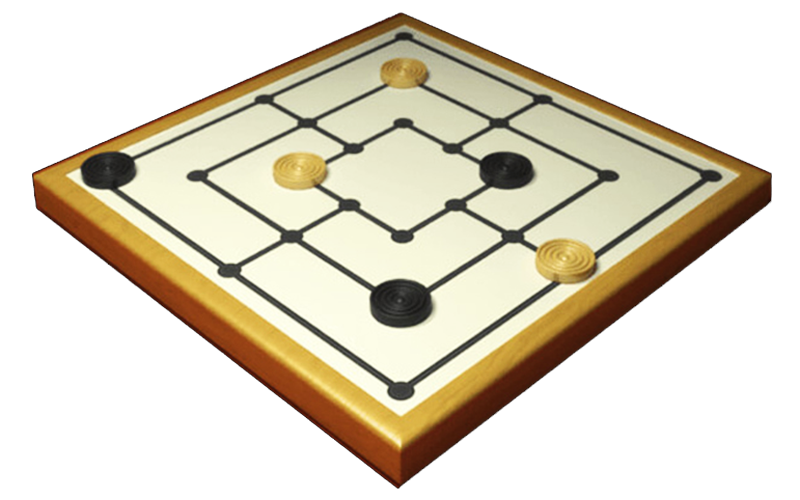

A game that combines strategy and tactics, and can be surprisingly deep and enjoyable. Nine Men’s Morris is believed to have been played in the Roman Empire, and is also referred to as nine-man morris, mill, mills, the mill game, merrills, ninepenny marl and “cowboy checkers” (it was often printed on the back of checkerboards). Play against the computer or versus a friend:
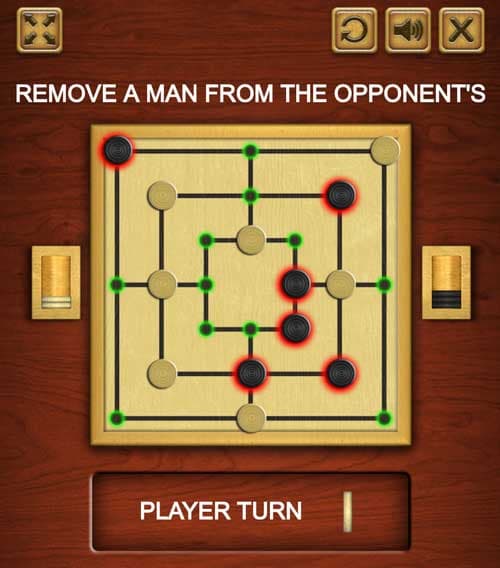
This game opens as a regular web page. There is no login or installation required, and the game works on mobile devices, tablets and desktop PC.
Play Nine Men's Morris:


Nine Men's Morris is an ancient tabletop board game for two players. The aim of the game is to remove your opponent's game pieces (called "men") one at a time, by moving 3 of your own "men" into a row (called a "mill"). Each "mill" you make gives you the power to select one of your opponent's men for removal. While moving your pieces, you can use tactics and strategy to block your opponent from building his own "mill".
Press the play icon on the startup screen to start a game. Then choose game mode: 1 player (against the computer) or 2 players (taking turns on your local device).
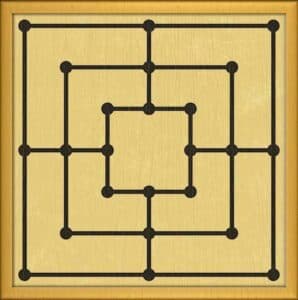
The Nine Men’s Morris game board
A Nine Men’s Morris board consists of three concentric squares connected by lines in the middle of each side. There are 18 game pieces (often referred to as “men”): 9 for each player, in two distinct colors (black and white). The board is empty at the start of the game, and each player is given 9 game pieces in one of the colors. They then take turns in placing one piece on the board at a time until they have no more pieces left to place.
When placing the "men" on the board, it is essential to block the opponent from getting 3 "men" in a row, which will give him the opportunity to remove one of yours.
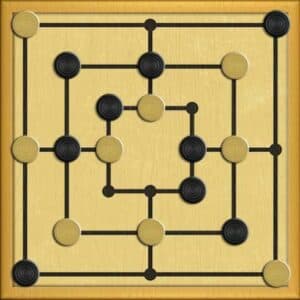
Placing the pieces on the board
After all pieces have been placed, players take turns moving a piece to an adjacent point along the lines. You cannot “jump” over another piece or an empty spot.
The goal is to form ‘mills’ (a row of three pieces) and remove the opponent’s pieces from the board. The winner is the player who reduces their opponent to two pieces, or blocks all their moves.
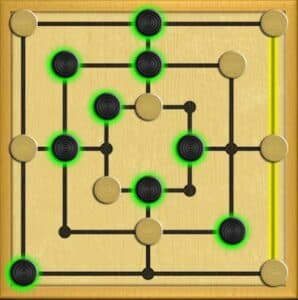
White player got a MILL in the right side (highlighted in yellow) and can remove one of the black pieces (highlighted in green)
A ‘mill’ is formed when three of a player’s pieces are in a straight line, either horizontally or vertically. When a player forms a mill, they remove one of their opponent’s pieces from the board. The removed piece should be from a non-mill formation unless no such pieces are available. If a mill is broken and re-formed, it counts as a new mill.
Flying: In some variations, when a player is reduced to three pieces, they can ‘fly’ to any empty spot on the board, instead of moving to an adjacent point.
Draws: The game can end in a draw if a certain position is repeated three times.
Blocking: A player wins if their opponent can’t make a move.
There are many regional variations to “Nine Men’s Morris”, so rules might slightly differ. This online game is a regular version for two players only, either you against the computer or you against a friend on the same device.
Good luck!
Learn more about this game on the Wikipedia Page
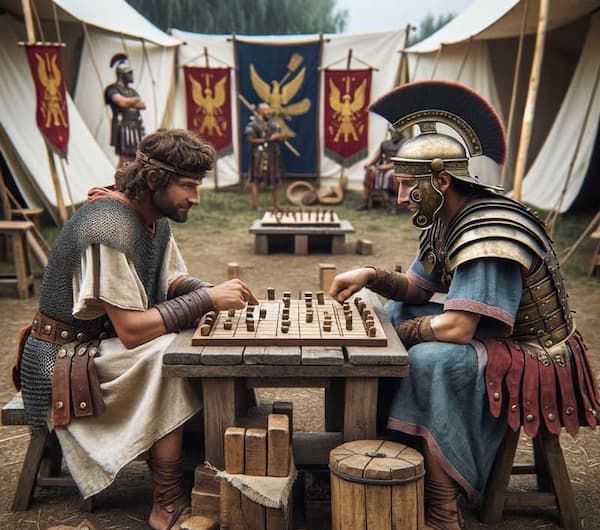
Romans playing a Board Game tournament
Nine Men’s Morris is an ancient board game that has captivated minds for centuries. This strategy game boasts a rich history, tracing back to the cradle of civilization.
The earliest known traces of Nine Men’s Morris appear in the ruins of the Bronze Age city of Ur in Mesopotamia, dating back to about 3000 BCE. This finding suggests that the game was a popular pastime amongst the early city dwellers. The game’s presence in the archaeological records of ancient Egypt, specifically in the temple of Kurna (circa 1400 BCE), further testifies to its antiquity and widespread appeal.
The game gained significant popularity in the Roman Empire. Evidence of Nine Men’s Morris boards carved into Roman architecture, such as the Colosseum, indicates its widespread popularity among all classes. The game persevered through the Middle Ages in Europe, becoming a mainstay in taverns and homes. Medieval manuscripts, including the famous “Libro de los juegos” (Book of Games) commissioned by King Alfonso X of Castile in the 13th century, feature detailed instructions and illustrations of the game, underscoring its importance in medieval culture.
The game’s simplicity allowed it to traverse cultures and geographies. Variations of Nine Men’s Morris emerged globally, with notable versions like “Merels” in England, “Mühle” in Germany, and “Morabaraba” in southern Africa, each adapting to local cultures and preferences. In the 20th century, Nine Men’s Morris experienced a revival due to increased interest in traditional board games. Modern adaptations have seen it transition to online platforms, making it accessible to a new generation of players.

Playpager's Nine Men Morris Game is a H5 web game programmed in html5/Js. You can play against the built-in computer player, 'Albert the AI', or against a friend in 2-player mode.
Play Nine Men's Morris:
A brief presentation:

